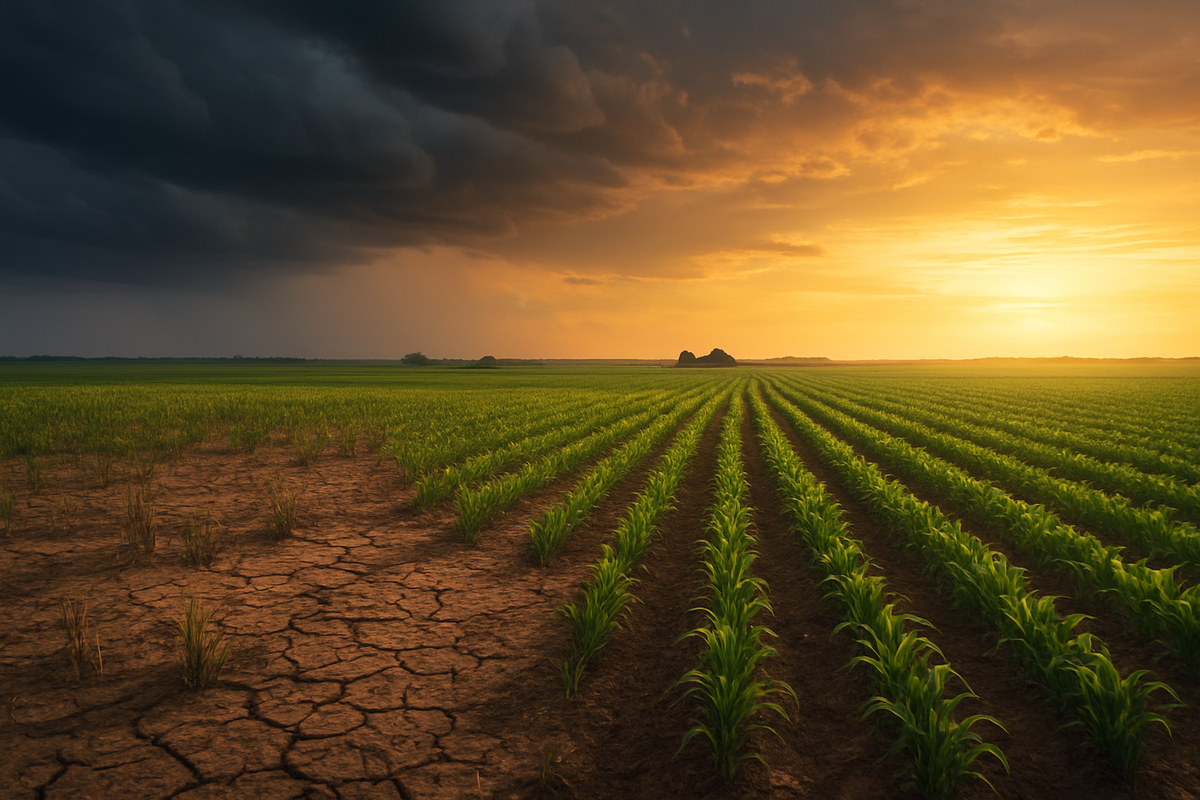
Washington D.C. – November 17, 2025 – The U.S. Department of Agriculture (USDA) has delivered a critical lifeline to American farmers and ranchers, rolling out a comprehensive package of disaster assistance for losses incurred during the 2023 and 2024 calendar years. Authorized by the landmark American Relief Act of 2025, this multi-billion dollar initiative aims to stabilize an agricultural sector battered by an unprecedented series of natural disasters and economic headwinds. With enrollment for a key program opening next week and promises of additional aid for 2025 "coming soon," the USDA's actions are poised to significantly reshape the financial landscape for producers and the broader agribusiness market.
The aid package, totaling over $30 billion, provides crucial financial stability, offsetting reduced revenues and high operational costs that have plagued farmers. This timely intervention is expected to prevent further erosion of financial positions for countless agricultural operations, ensuring continuity in food production and bolstering rural economies. As the industry grapples with the long-term effects of climate change and market volatility, this federal support underscores a renewed commitment to agricultural resilience.
A Detailed Look at the American Relief Act and Its Implementation
The American Relief Act of 2025, signed into law on December 21, 2024, by President Harris, allocated a staggering $30.78 billion in farm relief. Of this, approximately $20.78 billion is specifically directed towards natural disaster losses from 2023 and 2024, encompassing a wide array of devastating events including wildfires, hurricanes, floods, derechos, excessive heat, tornadoes, winter storms, freeze events, smoke exposure, excessive moisture, and qualifying droughts. An additional $10 billion is designated for economic assistance for 2024 commodities, aiming to mitigate market-driven losses.
The USDA, under Secretary Brooke L. Rollins, has meticulously rolled out several key programs to distribute this aid. The cornerstone is the Supplemental Disaster Relief Program (SDRP), backed by over $16 billion. SDRP Stage 1, which launched on July 9, 2025, targeted producers with indemnified losses (those covered by federal crop insurance or the Noninsured Crop Disaster Assistance Program, NAP), with pre-filled applications simplifying the process. Today, November 17, 2025, marks the announcement of the SDRP Stage 2 enrollment period, set to open on November 24, 2025, and close on April 30, 2026. This second stage is designed to cover non-indemnified, uninsured, and quality losses for eligible crop, tree, bush, and vine producers, and extends coverage to milk and on-farm stored commodity losses, addressing previous gaps in disaster relief.
Beyond crops, the Emergency Livestock Relief Program (ELRP) allocates approximately $2 billion for livestock producers. An ELRP for Drought and Wildfire for 2023 and 2024 automatically issued payments to eligible producers by May 30, 2025, while an ELRP for Flood and Wildfire commenced sign-ups on September 15, 2025. Other vital programs include the Milk Loss Program (MLP) for dairy operations and the On-Farm Stored Commodity Loss Program. Furthermore, the USDA is utilizing block grants to provide targeted compensation in specific states, including Florida, Georgia, and the Northeast, ensuring localized support. A crucial requirement for SDRP recipients is the mandatory purchase of crop insurance or NAP coverage at a 60% level or higher for the subsequent two crop years, a measure designed to foster long-term risk management.
Market Movers: Winners and Losers in the Wake of Aid
The influx of federal aid is expected to have a ripple effect across the agricultural supply chain, creating distinct winners and a more stable environment for others.
Agricultural Input Suppliers stand to be significant beneficiaries. Companies like CF Industries Holdings, Inc. (NYSE: CF), Nutrien Ltd. (NYSE: NTR), Corteva, Inc. (NYSE: CTVA), and The Mosaic Company (NYSE: MOS), which provide essential seeds, fertilizers, and crop protection chemicals, will likely see sustained or increased demand. With improved farmer liquidity, producers are better positioned to purchase necessary inputs for upcoming growing seasons, reducing pressure on suppliers to cut prices and potentially improving their margins. This financial injection helps ensure that the agricultural sector remains a viable customer base for these global giants.
Similarly, Agricultural Machinery Manufacturers such as Deere & Company (NYSE: DE), AGCO Corporation (NYSE: AGCO), and CNH Industrial N.V. (NYSE: CNHI) could experience a boost. Farmers who avoid severe financial distress due to disaster payments are more likely to invest in new equipment, replacement parts, and maintenance services. This sustained demand for capital goods is vital for manufacturers, particularly as the sector increasingly adopts precision agriculture technologies.
Agricultural Insurance Companies are also poised for a positive indirect impact. While they bear the initial brunt of disaster claims, the Federal Crop Insurance Program is a public-private partnership where the government reinsures a significant portion of policies. More importantly, the SDRP's "linkage requirement"—mandating recipients to purchase federal crop insurance or NAP coverage for two subsequent years—will directly boost customer enrollment and premium revenues for Approved Insurance Providers (AIPs). Major players like American Financial Group (NYSE: AFG) (via Great American Insurance Group) and Chubb Ltd. (NYSE: CB) (via Chubb Agribusiness), as well as QBE Insurance Group (ASX:QBE) (via NAU Country), will likely see their customer bases expand, solidifying the role of risk management tools in the farming community.
For Agricultural Commodity Traders like Archer-Daniels-Midland Company (NYSE: ADM) and Bunge Global SA (NYSE: BG), the impact is more nuanced. While a stabilized farming sector ensures a more consistent supply of raw materials, which is generally favorable, the aid could also temper commodity price spikes that would otherwise benefit traders holding long positions. If aid encourages increased planting, it could lead to higher supply, potentially putting downward pressure on prices. However, the overall stability brought by the payments reduces supply uncertainty, which is a net positive for long-term planning and global food security.
Broader Significance and Industry Trends
The USDA's disaster payments and the American Relief Act of 2025 represent more than just financial relief; they underscore a critical shift in how the nation addresses the escalating challenges faced by its agricultural sector. This event fits squarely into broader industry trends marked by increasing climate volatility and the growing necessity of robust risk management strategies. The frequency and intensity of natural disasters are compelling governments worldwide to re-evaluate their support mechanisms for agriculture, and the U.S. is no exception.
The legislation also carries significant regulatory and policy implications. The American Relief Act notably extended the existing Farm Bill through September 30, 2025, and commodity programs through the 2025 crop year. This extension provides crucial stability, preventing the activation of "permanent law" provisions that would have had disruptive effects on commodity markets. The mandatory crop insurance requirement tied to SDRP aid is a powerful policy lever, reinforcing the USDA's long-term goal of fostering a culture of proactive risk management among producers, rather than solely relying on ad-hoc disaster assistance. This move aims to build a more resilient agricultural economy capable of weathering future shocks.
Historically, federal disaster aid has often been criticized for being slow, complex, and unevenly distributed. The USDA's current approach, with streamlined processes like pre-filled applications and targeted programs for shallow and uninsured losses, reflects lessons learned from past events. While the scale of this aid package is substantial, it builds on precedents set by previous ad-hoc disaster assistance, but with a more integrated and forward-looking strategy that emphasizes risk mitigation alongside recovery. This comprehensive approach signals a maturation of federal agricultural policy in response to evolving environmental and economic realities.
What Comes Next: Navigating the Future of Farm Support
Looking ahead, the agricultural sector is poised for several key developments in the wake of this extensive aid package. In the short term, the immediate focus will be on the successful implementation of SDRP Stage 2, with enrollment opening on November 24, 2025. This stage is critical for reaching producers who previously fell through the cracks of traditional insurance or ad-hoc programs, ensuring a more equitable distribution of relief. Furthermore, the announcement from Deputy Secretary Stephen Vaden today, November 17, 2025, promising an "announcement regarding aid for 2025 will be coming soon," signals that federal support for the agricultural sector is likely to continue into the next calendar year, providing a forward-looking assurance for producers planning their next crop cycles.
In the long term, the implications are profound. The mandatory crop insurance requirement for SDRP recipients will likely lead to increased participation in federal risk management programs, fostering a more resilient and self-reliant agricultural industry. This could catalyze new market opportunities for agricultural technology and data analytics firms specializing in risk assessment and mitigation. However, the ongoing challenge of climate change will continue to demand strategic pivots and adaptations from farmers, government agencies, and agribusinesses alike. Discussions around the next comprehensive Farm Bill, which will shape agricultural policy for years to come, will undoubtedly be influenced by the experiences of the 2023-24 disaster years and the effectiveness of the current aid programs.
Potential scenarios and outcomes include a more stable commodity market due to reduced financial distress among producers, but also continued pressure on federal budgets to fund ongoing disaster relief. Agribusinesses may find sustained demand for inputs and machinery, but also face evolving demands from farmers seeking climate-resilient solutions. The emphasis on risk management could also spur innovation in agricultural insurance products and services, creating new avenues for growth and partnership within the sector.
A Comprehensive Wrap-Up: Stability and Strategic Adaptation
The USDA's 2023-24 disaster payments, enacted through the American Relief Act of 2025, represent a monumental effort to stabilize the American agricultural sector. The key takeaways are clear: significant financial relief has been provided, processes have been streamlined, and there's a strong push towards integrating proactive risk management strategies through mandatory insurance requirements. This initiative not only addresses immediate losses but also lays groundwork for greater resilience in the face of future climate challenges.
Moving forward, the market will largely assess the effectiveness of these programs in fostering long-term stability. The successful rollout of SDRP Stage 2 and the details of the upcoming 2025 aid will be critical indicators. Investors should closely watch for continued government commitment to agricultural support, the evolution of crop insurance markets, and the performance of key agricultural companies—particularly those in the input and machinery sectors—as farmer liquidity improves. The interplay between federal policy, climate realities, and market dynamics will define the agricultural landscape in the coming months and years.
This content is intended for informational purposes only and is not financial advice





